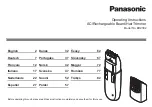
11
Trimming
80 mm above
ground
SCALPING
-- The scalping technique re-
moves unwanted vegetation down to the
ground. Hold the bottom of the trimmer head
about 80 mm above the ground and at an an-
gle. Allow the tip of the line to strike the
ground around trees, posts, monuments, etc.
This technique increases line wear.
MOWING
-- Your trimmer is ideal for mow-
ing in places conventional lawn mowers
cannot reach. In the mowing position, keep
the line parallel to the ground. Avoid press-
ing the head into the ground as this can
scalp the ground and damage the tool.
SWEEPING
-- The fanning action of the rotat-
ing line can be used to blow away loose de-
bris from an area. Keep the line parallel to and
above the area surface and swing the tool
from side to side.
OPERATING INSTRUCTIONS FOR
USE WITH WEED BLADE
S
Blade Thrust
is a reaction that only occurs
when using a bladed unit. This reaction can
cause serious injury such as amputation.
Carefully study this section. It is important that
you understand what causes blade thrust,
how you can reduce the chance of its
occurring, and how you can remain in control
of unit if blade thrust occurs.
S
WHAT CAUSES BLADE THRUST
--
Blade
Thrust
can occur when the spinning blade
contacts an object that it does not cut. This
contact causes the blade to stop for an instant
and then suddenly move or “thrust” away
from the object that was hit. The “thrusting”
reaction can be violent enough to cause the
operator to be propelled in any direction and
lose control of the unit. The uncontrolled unit
can cause serious injury if the blade contacts
the operator or others.
S
WHEN BLADE THRUST OCCURS
--
Blade Thrust
can occur without warning if
the blade snags, stalls, or binds. This is
more likely to occur in areas where it is
difficult to see the material being cut. By
using the unit properly, the occurrence of
blade thrust will be reduced and the
operator will be less likely to lose control.
S
Cut only grass, weeds, and woody brush up
to 13 mm in diameter with the weed blade.
Do not let the blade contact material it
cannot cut such as stumps, rocks, fences,
metal, etc., or clusters of hard, woody brush
having a diameter greater than 13 mm.
S
Keep the blade sharp. A dull blade is more
likely to snag and thrust.
S
Cut only at full throttle. The blade will have
maximum cutting power and is less likely to
bind or stall.
S
“Feed” the blade deliberately and not too
rapidly. The blade can thrust away if it is fed
too rapidly.
S
Cut only from your left to your right. Cutting
on right side of the shield will throw debris
away from the operator.
S
Use the shoulder strap and keep a firm grip
on the unit with both hands. A properly
adjusted shoulder strap will support the
weight of the unit, freeing your arms and
hands to control and guide the cutting
motion.
S
Keep feet comfortably spread apart and
braced for a possible sudden, rapid thrust of
unit. Do not overreach. Keep firm footing and
balance.
S
Keep blade below waist level; it will be
easier to maintain control of unit.
S
Do not raise the engine above your waist as
the blade can come dangerously close to
your body.
Summary of Contents for GT32L
Page 1: ...530088107 11 14 01 ...
Page 15: ...15 SAFETY ...
Page 16: ...16 SAFETY Jonsered SE 561 82 Huskvarna Huskvarna Sweden ...


































